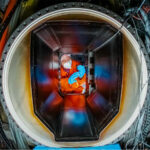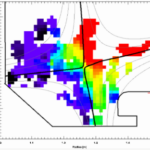Capabilities and Tools for Plasma Science Research
DIII-D is a flexible plasma science research facility. It operates as an open program to which members of the worldwide fusion community can propose ideas. Ideas are selected on the basis of their potential to advance the science, techniques and predictive capabilities for future fusion energy devices such as ITER, future nuclear science facilities and power plants. The research program also seeks to address foundational scientific questions underlying fusion-relevant plasma behavior.
The program represents a broad collaboration of approximately 100 participating institutions and covers a wide range of topical areas that are important in fusion and plasma science. Research focuses on the aspects that are most important to future devices, as well as investigating key questions that are best addressed with the distinctive capabilities of the DIII-D tokamak. There are also allocated resources to address more fundamental plasma science questions relevant to other areas of plasma physics that are a priority in the US program.
The DIII-D program welcomes further participation to further advance the understanding of plasma physics. To this end, we have compiled this Capabilities page to help advise potential new users on what can be done at this facility.
An extensive review of DIII-D capabilities and tools can be found here.
Physics Parameters

Learn more about DIII-D’s Key physics parameters.
Equipment systems

The DIII-D tokamak is renowned for its operational flexibility with a carbon wall, enabling a wide range of research projects in highly shaped limiter and divertor plasma configurations.
Diagnostics Systems

The DIII-D diagnostic portfolio includes over 100 diagnostic systems capable of providing definitive measurements of plasma parameters in the core, edge and boundary regions of the plasma.
Physics Parameters
Dimensional Parameters:
- Major radius: 1.7 m, minor radius: 0.6 m
- Density: typically 0.3-1.5×1020 m-3
- Plasma current: 0.4 to 2 MA
- Toroidal field: 0.6 to 2.17 T
- Safety factor at 95% surface: ~2-12
- Heating power: 20 MW beam (25 MW planned), 3 MW ECH (7 MW planned), 1 MW helicon, 1 MW LHCD (planned operation: 2025)
Normalized Parameters:
- Magnetic Reynolds number: 109, ρ*=.005-0.01, ν*=0.01-10
- β to 5%, βΝ to 5, βP to 3, fast ion fraction from 0 to 40%
- βFI≤ βthermal, vfast ion ~ vAlfvén, velectron thermal >> vAlfvén

Diagnostics Systems
Diagnostics Systems page coming soon.

